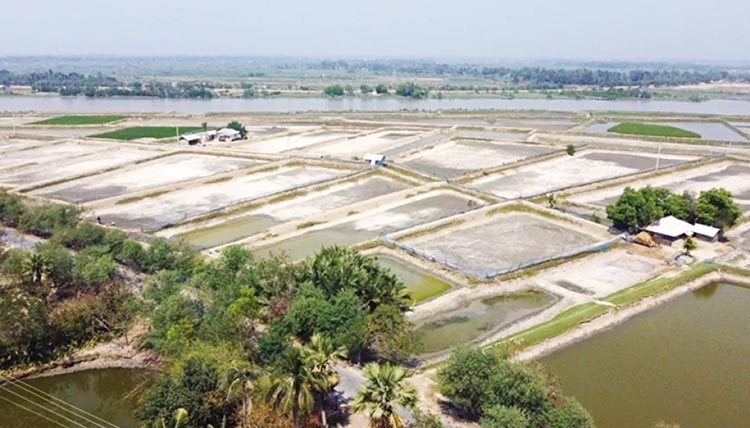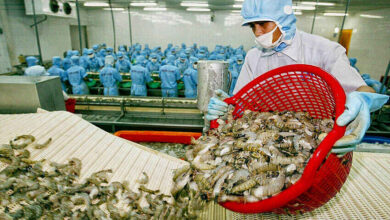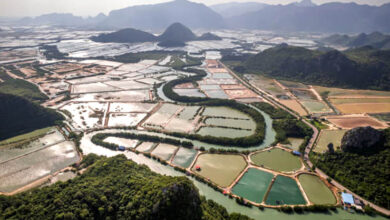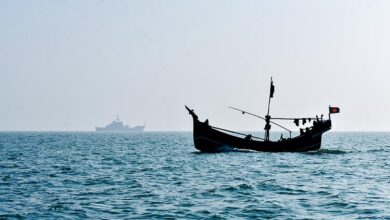
The implementation of cluster-based shrimp farming in the coastal areas of Khulna and Bagerhat has brought new opportunities for farmers by increasing production and reducing shrimp mortality. Approximately 7,500 shrimp farmers have been included in the Sustainable Coastal and Marine Fisheries project led by the Department of Fisheries.
In recent years, shrimp farmers in the southern region have faced significant losses due to diseases and flooding caused by natural disasters. Experts believe that cluster-based farming has the potential to significantly boost shrimp production if sustainability and long-term project success can be ensured.
However, adapting traditional enclosures for cluster cultivation requires substantial investment, which many farmers are unable to secure despite their enthusiasm. As part of the Sustainable Coastal and Marine Fisheries Project, 300 clusters have undergone modernization, with each cluster comprising 25 enclosures ranging in size from 33 decimals to 150 decimals.
Cluster cultivation involves the collaboration of farmers in a specific area, working together in an organized and coordinated manner to achieve common goals. According to Saroj Kumar Mistry, Deputy Director of the Khulna Divisional Sustainable Coastal and Marine Fisheries Project, cluster shrimp farming presents new possibilities for increasing safe shrimp production, promoting coastal agro-economy, alleviating poverty, and achieving Sustainable Development Goals (SDGs). It is also seen as an effective strategy for increasing shrimp production and addressing climate-related risks.
Fisheries officers are providing training to farmers on modern shrimp farming techniques, focusing on aspects such as enclosure depth, biosecurity measures, road expansion, use of PCR lab-tested virus-free PCF fry stock, and good aquaculture practices.
Under the cluster farming model, farmers are encouraged to apply for matching grants after preparing their enclosures according to project guidelines. Currently, non-refundable financial grants of Tk 1.81 lakh per acre are being provided to farmers in 200 clusters. The grants cover various expenses, including lime purchase, prebiotics, probiotics, fry stock, supplementary food, electricity connection, office construction, and necessary equipment.
However, many cluster farmers face challenges in excavating enclosures and constructing roads as per the project guidelines due to a lack of capital. Consequently, only 107 clusters have received matching grants, subject to meeting the specified conditions. On April 28, the Department of Fisheries issued matching grant checks to 24 clusters in the initial phase of verification, and these clusters are now preparing fry stocks with the expectation of improved production.
Farmers who have embraced the cluster system have reported significant increases in shrimp production. Suvendra Biswas, President of the Boro Danga Prawn Farmers Cluster-1, mentioned that by following the instructions provided by fisheries officers, he successfully cultivated shrimp in the cluster system, resulting in more than a twofold increase in production. Despite some delays, he expressed satisfaction with the financial support received through matching grants.
Md Enamul Haque Bablu, General Secretary of the Deyara Paschimpara-1 Prawn Farmers Association, explained that their cluster was formed based on the advice of fisheries officials and they received training in modern shrimp farming techniques. While their harvests have increased, financial constraints have prevented them from excavating enclosures to increase depth, causing concerns about their exclusion from the cluster program.
Officials, such as Dumuria Senior Upazila Fisheries Officer Md Abu Bakar Siddique, have emphasized the benefits of cluster farming, citing increased production and the possibility of cultivating different types of prawns on the same land. The interest in cluster farming is growing among the local population due to its profitability.
In Dumuria, a total of 18 clusters exist, with five clusters receiving matching grant checks in the first phase. Bagerhat District Fisheries Officer ASM Russell reported the presence of 96 clusters in Bagerhat, of which 16 applied for matching grants and met the conditions.
One cluster of Rampal, three clusters of Chitalmari and three clusters of Sadar upazila have received financial support.
“Nine clusters of Mongla, Moralganj, Kachua and Fakirhat upazilas may get financial support in the second phase. I hope the production will increase a lot and the farmers will benefit from this method,” he said.




